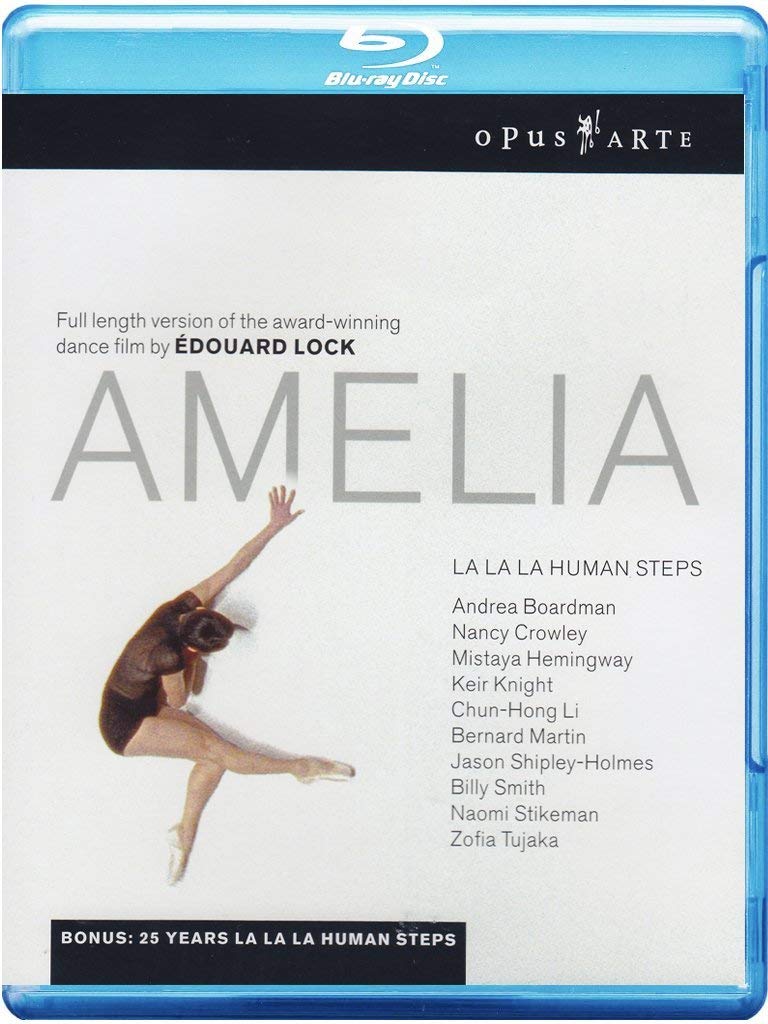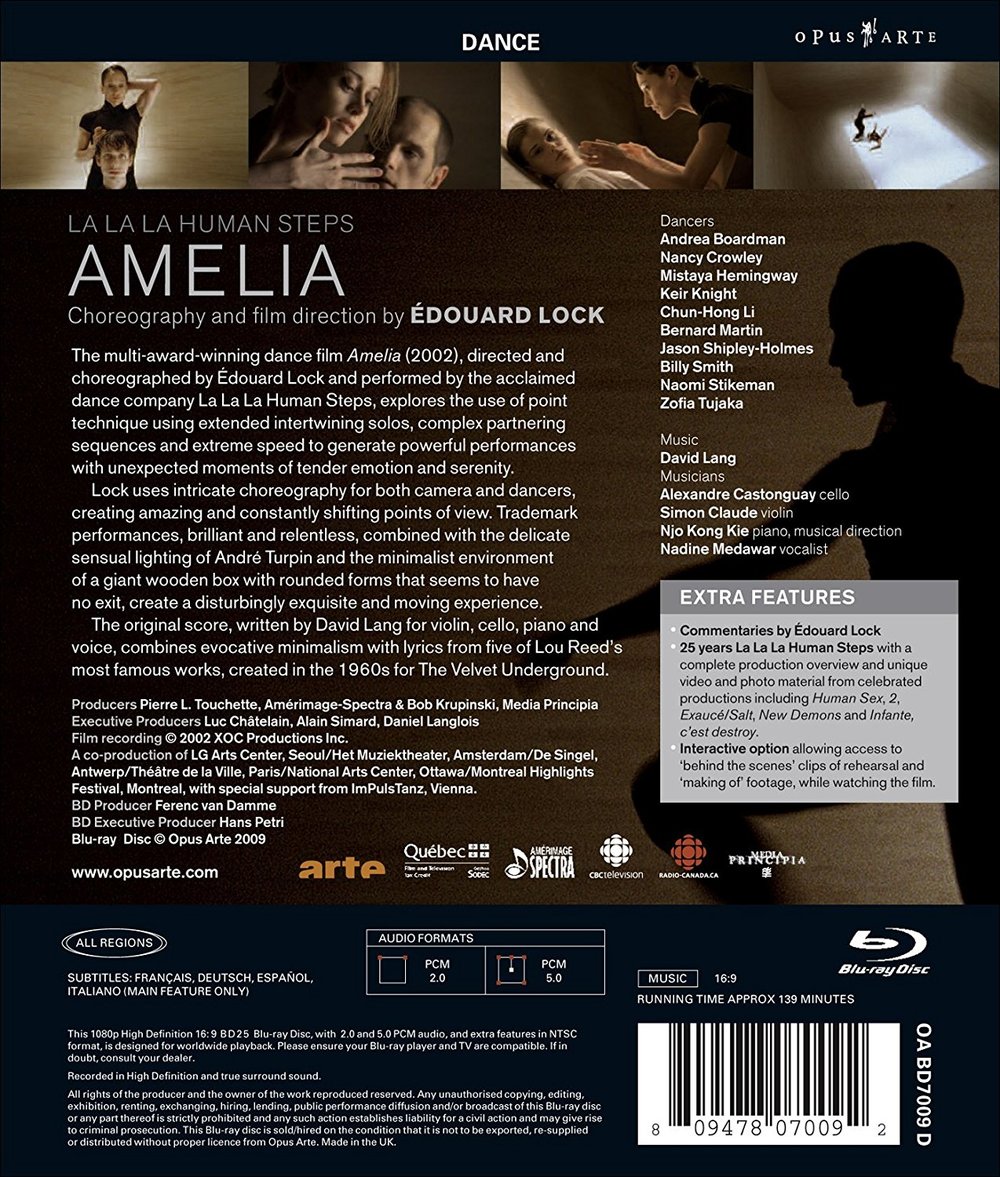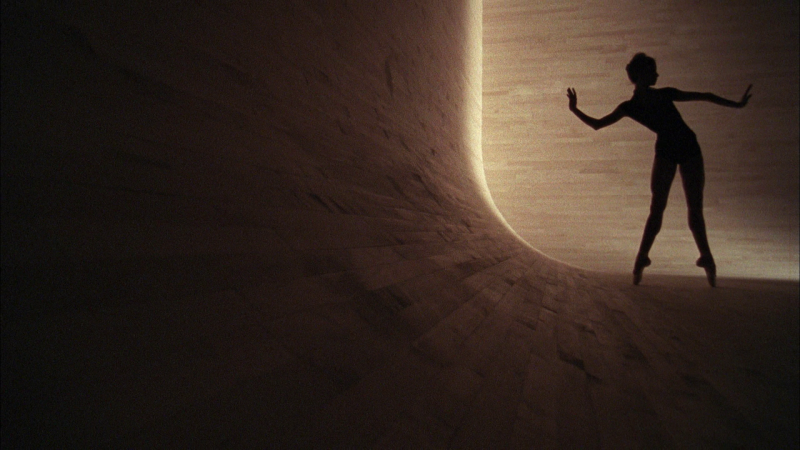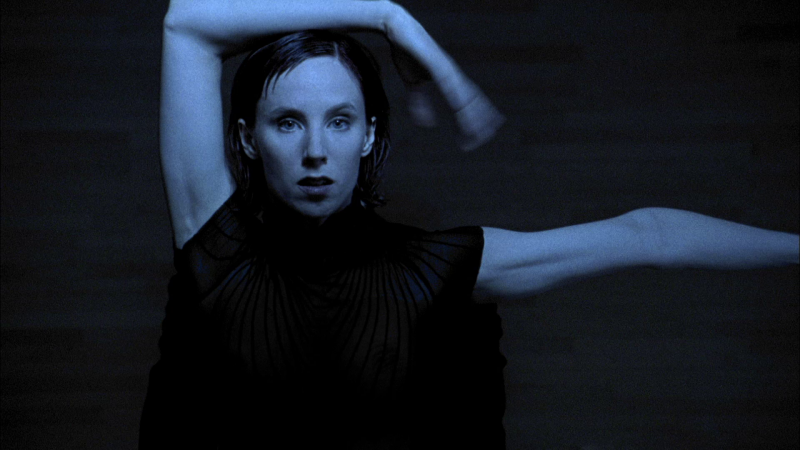

Amelia modern dance movie. Music by David Lang with lyrics by Lou Reed (and, per urban legend, Nico, a friend of Andy Warhol). Choreography by Édouard Lock, leader of the dance group LaLaLa Human Steps. Lock first created a theater version of Amelia. Then in 2002 he also directed and edited the movie version we review here, which was shot on super 16 motion picture film at 24 fps. The dancers are Andrea Boardman, Nancy Crowley, Mistaya Hemingway, Keir Knight, Chun-Hong Li, Bernard Martin, Jason Shipley-Holmes, Billy Smith, Naomi Stikeman, and Zofia Tujaka. Musicians are Alexandre Castonguay (cello), Simon Claude (violin), Njo Kang Kie (piano and musical direction), and Nadine Medatwar (vocalist). Unique set designed by Lock; photography directed by André Turpin; costumes by Vandal; Folley effects by Lisa Wedlock (the film was shot silent and all sound comes from post-production); sound design by Hans-Peter Strobl and Lisa Wedlock; artistic director was Louise Marie Beauchamp. Producers were Pierre L. Touchette and Bob Krupinski; executive producers were Luc Châtelain, Alain Simard, and Daniel Langlois. There are valuable extras: (1) Director's Commentary in English and French as movie plays, (2) an interactive feature that takes you from the movie to 32 "how we did it" documentary clips, and (3) history of LaLaLa Human Steps. (Instructions in booklet on using the interactive feature are wrong: correct instructions are on disc.) Released 2009, disc has 5.0 PCM sound. Grade: A+
In 2002, Lock was a famous choreographer, but he was new to movies. He somehow rounded up the money to try his hand at designing and directing a motion picture version of Amelia. The choreography would be similar to the stage version. But he would attempt to recreate Amelia in a new world that would never seen by a actual spectator. The set, constructed solely (I think) for this film, seems to be a stage of light-colored maple flooring folded up into a box with rounded corners and high walls. The box seems to isolate the dancers in a kind of trap. I say "seems" because, as you can see in interactive extra clips, the stage breaks down into various components like a Lego set for giants, and the pieces are used in various ways. The images you see on the film are as much illusion as real, but all the effects are purely mechanical or physical (nothing digital).
The making of a movie is a totally different experience than creating a theater show, especially for the dancers, who must stay psyched up to perform while waiting endlessly for people to fidget with gear and the director to make countless retakes. The dance style, which I call "Lock logic," is based on classical ballet, but the 18th century concepts of aristocratic grace and elegance have been replaced with a Lock logic emphasis on power, speed, and slick style. Lock also adds curious motions of the arms and hands to the mix which I first thought might be mime or some kind of sign language. But I now believe these unpredictable motions are part of Lock's effort to interfere with normal expectations (see the discussion of "deconstrutive revelation" after the screenshots). The women, dressed in revealing black tights, are panthers specializing in incredibly fast moves. The men, dressed in black suits and white shirts, mostly support the women, but they have their own funky vocabulary as well.
One of Lock's objectives was to create a dialogue between the camera and the Lock logic of the dancers. He attempted to present as many different views of the dancing as would be possible with his resources. Even though there is only one bare set, no scenery, no prop, no plot, no named characters, and no costume changes, Amelia is not monotonous. As soon as your brain has acquired focus on the current clip, Lock throws something different at you. The change of views proceeds rapidly; and, except for a number of views of repose, the action in each view is fast and exciting.
The music is partly ethereal and partly jazz from the streets. Most of it is not "danceable." I get the impression that the dancers performed in silence on the film and that the music was added later (along with Foley effects such as the sound of the point shoes striking the floor). So the music is background for the choreography. But because the music is so good and always appropriate for the dancing, the effect is most satisfactory.
Lyrics from 5 Lou Reed songs are included: (1) "I'm Waiting for the Man" (Track 1), (2) "I'll be Your Mirror" (Track 7), (3) "Sunday Morning" (Track 10), and "Heroin" (Track 11 and 12) and "All Tomorrow's Parties" (Track 13). Some of the lyrics have a masculine brutality about them. Other lyrics are more feminine, such as "All Tomorrow's Parties", in which the protagonist is a pathetic slum Cinderella. The lyrics are sung in English, but there are no English subtitles. Because of the way the lyrics are sung, I could only understand a few words. So I "reverse engineered" the German and Spanish translations to identify the songs, all of which are known by heart by Lou Reed and Velvet Underground fans. (As used in Amelia, the Lou Reed songs sound completely different from the Velvet Underground recordings.) I've added the text or the lyrics as a footnote * to help you to follow them.
With this background, it's time now for some screenshots.
Our first shot shows 3 walls of the box. Your mind assumes there are 4 walls. But as you can see in the interactive extras, this was probably made with 3 walls and an open space to make it easier to set up the cameras and for the dancers to get to their positions. Most of the scenes in the movie are duets and solos. Here we have the largest ensemble in the show with the "male quartet" performing with exciting jazz music in background:
Lock tries to use every possible combination of light and dark in his clips. Below is one of the opening scenes which provides a good example of this:
Lock attempts to use as many angles as he can, the odder the better. Below the camera shoots straight down on Chun-Hong Li and Jason Shipley-Holmes. You might have a hard time understanding this image but for the shadow of Chun-Hong Li on the floor:
In the shot below, the movement of the shadows is more interesting than what you can see of the dancers:
Lock also includes many gorgeous close-up shots such as this one of Mistaya Hemingway:
And next below is an extreme close-up. The text here says (roughly) "Don't you know the night has seen the darkness of your soul." What better way for the night to do this than to peer into the soul through an eye:
Here we see all 4 sides of the box. To get to the floor for this, the dancers enter the box through a curved door that pops out of the lower part of a wall. You would think the walls are 100 feet high. This is an illusion created, I think, with a special camera lens:
I haven't forgotten that this is a dance performance. The typical cut is a duet such as this one below with Jason Shipley-Holmes and Andrea Broadman. Andrea performs an astonishing sequence of fast moves while Jason keeps her from injuring herself. The duets are well-grounded---there is not a single lift in the whole production:
The dancers pair up in various male/female combinations. Here Andrea Boardman, who was past normal retirement age for a dancer, works with Keir Knight, a dancer so young that Andrea could be his mom:
Andrea again with Bernard Martin:
In the midst of all the fast action, Lock also includes scenes of introspection and tenderness like this image below of Billy Smith and Zofia Tujeka:
Here Billy and Zofia again. Billy is an male expert at dancing on point, and he is not afraid to wear lipstick:
This is my favorite shot of Nancy Crowley:
In 2002, Chun-Hong Li had just come from China to join LaLaLa Human Steps. According to a commentary from Lock, she did not speak enough English or French to fully understand what was expected of her. But you can't tell this from the film. I think body language in humans predates the development of sung or spoken language and is therefore universal. From the first time I saw it, I felt powerfully attracted to her in the scene shown below with Keir Knight:
The dominate colors in this film are maple-flooring tan, skin tones, black, and a bit of lipstick. However, here are shots from a terrific performance by Naomi Stikeman (with Jason) in a "blue" spot light:
This last shot is an attempt to convey the explosive power of the dancers shown throughout this film. Here you see two of the men leaping and spinning around Andrea Boardman. The aspect of Amelia just can't be accurately depicted in still photography:
A total-control artist, Lock used post-production to get a slightly muted, grainy patina for this show that reminds me of the Lars von Trier movies. This title doesn't have that razor-sharp look of later HDVDs. But it still looks great in Blu-ray and it probably looks better in the home theater than it ever looked on a movie screen.
So now we get to these burning questions: what is this about and who was Amelia?
The main theme of the show is a contemplation of the loneliness and isolation of life in the materialistic society. It is also a lament over the futility of trying to use drugs to deal with loneliness and isolation. Not too much new at this point. The trap in which the dancers perform is a metaphor for the isolation they feel. The dancers are heavily weighted down with depression about their situation, but they still display bi-polar, manic levels of energy to protest and to strive to break free. Thus Lock logic breaks through our normal perception of dancers and leads to what Lock calls a "deconstrutive revelation" of their bodies, and, I think, their souls. In English, Lock is trying to shake you up so you can really see and appreciate the dancers. Because of the deconstructive revelation Lock achieves, this show is absorbing throughout, and the dancing is consistently awesome. I also feel wonder and compassion for these people who have worked so hard to be a part the exotic world of Lock logic.
Alas, I never figured out who Amelia is. There are 3 songs named for Amelia in the music (no lyrics). So I think Lock must be making reference with his title to some person or work of art. If you know about Amelia, please enlighten me!
Amelia was modestly successful as a theater ballet. The film was successful at festivals and on the art-movie circuit, and it earned prizes and awards. It doesn't seem dated 11 years after it was made. But I never heard of it until Opus Arte published the HDVD. So it seems to me that Amelia may now be entering a third life---it's life in the home theater.
This movie has a strange effect on me when I watch it in my HT. Usually I'm alone in my own small isolated box. As I watch the film, I start to feel that I am in the maple box with the dancers. Because there is no plot to demand my attention, I can concentrate on the thing that's really important about these dancers: I see and feel their pain. I get the crazy notion that I am in communion with them and that years later they will somehow sense this. I have a day dream that maybe one of the dancers will stumble onto this review via the Internet and tell me in an email what it was like to work with Lock on this film. You usually don't get these kind of ideas just watching a movie. But the beauty of this film and the intensity of the dancers transports me.
OR
*Here are some lyrics:
I'M WAITING FOR MY MAN (Track 1)
I'm waiting for my man
Got 26 dollars in my hand
Up to Lexington 125
Feelin' sick and dirty
I'm waiting for my man
Hey white boy, what you doin' uptown?
Hey white boy, you chasin' my women around?
Pardon me sir, it's furthest from my mind
I'm just waitin' for a dear-dear friend of mine
I'm waiting for my man, come on
Here he comes, he's all dressed in black
Puerto Rican shoes and a big straw hat
He's never early, he's always late
First thing you learn is that you always gotta wait
I'm waiting for my man
Up to a brownstone
Up three flights of stairs
Everybody's pinned you and nobody cares
He's got the works, gives you sweet taste
Then you gotta split because you got no time to waste
I'm waiting for my man
Hey baby, don't you holler, don't you ball and shout
I'm feeling good, I'm gonna work it on out
I'm feeling good, feeling so fine
Until tomorrow, but that's just some other time
I'm waiting for my man (repeats)
I'LL BE YOUR MIRROR (Track 7)
I'll be your mirror
Reflect what you are, in case you don't know
I'll be the wind, the rain and the sunset
The light on your door to show that you're home
When you think the night has seen your mind
That inside you're twisted and unkind
Let me stand to show that you are blind
Please put down your hands
'Cause I see you
I find it hard to believe you don't know
The beauty that you are
But if you don't let me be your eyes
A hand in your darkness, so you won't be afraid
When you think the night has seen your mind
That inside you're twisted and unkind
Let me stand to show that you are blind
Please put down your hands
'Cause I see you
I'll be your mirror (repeats)
SUNDAY MORNING (Track 10)
Sunday morning
Brings the dawn in
It's just a restless feeling
By my side
Early dawning
Sunday morning
It's all the wasted years
So close behind
Watch out the world's behind you
There's always someone around you
Who will call
It's nothing at all
Sunday morning
And I'm falling
I've got feeling
I don't want to know
Early dawning
Sunday morning
It's all the streets you've crossed
Not so long ago
Watch out the world's behind you
There's always someone around you
Who will call
It's nothing at all (repeats)
HEROIN (Tracks 11 and 12)
I don't know just where I'm going
But I'm goin' to try for the kingdom if I can
'Cause it makes me feel like I'm a man
When I put a spike into my vein
Then I tell you things aren't quite the same
When I'm rushing on my run
And I feel just like Jesus' son
And I guess I just don't know
And I guess that I just don't know
I have made very big decision
I'm goin' to try to nullify my life
'Cause when the blood begins to flow
When it shoots up the dropper's neck
When I'm closing in on death
You can't help me not you guys
All you sweet girls with all your sweet talk
You can all go take a walk
And I guess I just don't know
And I guess I just don't know
I wish that I was born a thousand years ago
I wish that I'd sailed the darkened seas
On a great big clipper ship
Going from this land here to that
I put on a sailor's suit and cap
Away from the big city
Where a man cannot be free
Of all the evils in this town
And of himself and those around
Oh, and I guess I just don't know
Oh, and I guess I just don't know
Heroin, be the death of me
Heroin, it's my wife and it's my life
Because a mainer to my vein
Leads to a center in my head
And then I'm better off than dead
When the smack begins to flow
Then I really don't care anymore
About all the Jim-Jims in this town
And everybody putting everybody else down
And all of the politicians makin' crazy sounds
All the dead bodies piled up in mounds, yeah
Wow, that heroin is in my blood
And the blood is in my head
Yeah, thank God that I'm good as dead
Ooohhh, thank your God that I'm not aware
And thank God that I just don't care
And I guess I just don't know
ALL TOMORROW'S PARTIES (Track 13)
And what costume shall the poor girl wear
To all tomorrow's parties?
A hand-me-down dress from who knows where
To all tomorrow's parties
And where will she go and what shall she do
When midnight comes around?
She'll turn once more to Sunday's clown
And cry behind the door
And what costume shall the poor girl wear
To all tomorrow's parties?
Why silks and linens of yesterday's gowns
To all tomorrow's parties
And what will she do with Thursday's rags
When Monday comes around?
She'll turn once more to Sunday's clown
And cry behind the door
And what costume shall the poor girl wear
To all tomorrow's parties?
For Thursday's child is Sunday's clown
For whom none will go mourning
A blackened shroud, a hand-me-down gown
Of rags and silks, a costume
Fit for one who sits and cries
For all tomorrow's parties

















